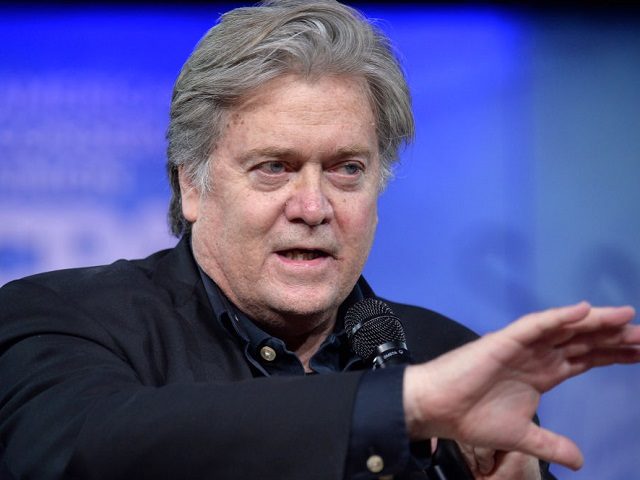A newly launched exhibition in Rotterdam showcases how Steve Bannon’s artistic work in film and culture “first foreshadowed, then shaped, the core narratives of Trumpism.”
Stephen K. Bannon, the former executive chairman of Breitbart News who led Donald Trump’s election campaign to victory before becoming the president’s chief strategist, has caught the attention of the art world as “one of this young century’s more significant propaganda artists.”
Designed by Jonas Staal and curated by Marina Otero Verzier, the exhibit, titled “Steve Bannon: a Propaganda Retrospective,” opened in Rotterdam on Friday at the Het Nieuwe Instituut and will run through next September 23.
“I don’t want to give him too much credit, because the idea that he’s a successful propagandist is, of course, all part of his propaganda,” said Jonas Staal, a Dutch artist and propaganda researcher who headed up the project.
“But it’s true that he has succeeded, like few others over the past 15 years, in turning an artistic representation of his ideas into political reality,” he said.
Bannon’s art, Staal contends, not only portrays reality; it alters and shapes it.
“He’s developed this artistic horizon, but it’s not a ‘what if’, it’s a script,” Staal said.
“And what Bannon’s work shows is that the script for Trumpism was written long before Trump came along. Our reality has been co-authored by Steve Bannon. His core ideas have become the contemporary paradigms we are living with today,” he said.
The Dutch show draws a direct line from Bannon’s early free-market activism through Breitbart to his role in the Trump presidency by offering extended clips from his nine documentaries, flanked by books, artefacts and information panels that add background and context.
Bannon’s nine films include Generation Zero (underscoring the “real” causes of the 2008 financial crisis), District of Corruption (tracing Washington corruption from the Clinton years through the Obama presidency), The Undefeated (on the redoubtable Sarah Palin), In the Face of Evil (Reagan’s struggle against communism), Battle for America (the rise of the Tea Party), and 2016’s The Torchbearer (starring Duck Dynasty’s Phil Robertson in a throw-down to post-Christian America).
As summed up by the Guardian, the show traces the development of Bannon’s “core ideology,” from “his near hero-worship of Ronald Reagan,” through the 9/11 attacks, to his engagement with the Tea Party, support for Sarah Palin, and disdain for the Occupy movement.
Bannon’s films, the Guardian argues, “reveal an apocalyptic world view,” with Western society, Christianity and freedom all under attack, especially from establishment insiders: corrupt government, big banks, and a cosmopolitan elite.
“Illegal immigration, crony capitalism and progressive liberalism are threatening the country; only economic nationalism, hardcore conservatism and a crushing victory in the coming clash of civilisations will save it,” the report states.
“There’s always, too, a search for leadership,” said Staal.
“Trump may be a rather imperfect version of the warrior he would ideally have liked, but the ideology is there, the battle between good and evil, the clash of civilisations,” he said. “Bannon believes that like the communists and Nazis before them, Islamic terrorism and the global elite must be defeated.”
Staal gives Bannon credit for effecting real change—political and cultural—not just inside America but abroad as well.
“These films were not made for the kind of audience that critiques them,” he said. “Of course, it’s easier to examine the core narratives than to measure their impact. But Trump’s successful campaign and, beyond the US, Leave’s victory in the UK’s Brexit referendum, the rise of the ultranationalists in the Netherlands, France, Italy – there’s clearly a link between the success of these campaigns and the platforms that carried their core messages.”
“What’s essential to realise about propaganda,” said Staal “is that it is not, actually, about sending a message. It’s about shaping our environment, engineering our reality.”
While Staal clearly admires Bannon for his prowess as a propagandist, he does not share his worldview. Rather than spreading Bannon’s message, the exhibition aims to “open up spaces and opportunities for critique – and resistance,” he said.
To counter Bannon’s vision, a different narrative must be advanced, Staal says.
“We need to define an ‘us’ that is a much more pluralistic reality. This has to be the task of progressive art and politics today: to tell a more inclusive story of who we are, and who we can still become. Because facts alone – as the Brexit vote showed very clearly – will convince no one.”
“We need a fact-based, alternative narrative,” he said.
Meanwhile, Steve Bannon shows no signs of slowing down his own work of promoting populist nationalism at home and abroad, as recent appearances in Italy, Switzerland, and France attest.
As Bannon told the New York Times in an interview last month: “All I am trying to be is the infrastructure, globally, for the global populist movement.”
Follow Thomas D. Williams on Twitter Follow @tdwilliamsrome

COMMENTS
Please let us know if you're having issues with commenting.